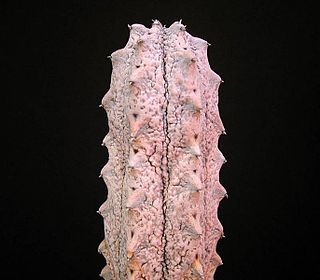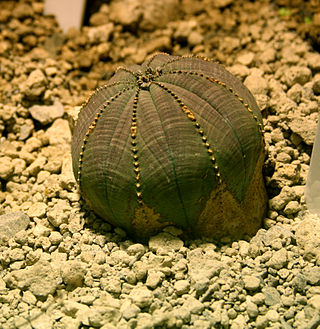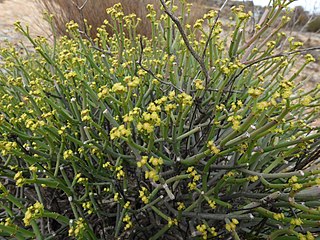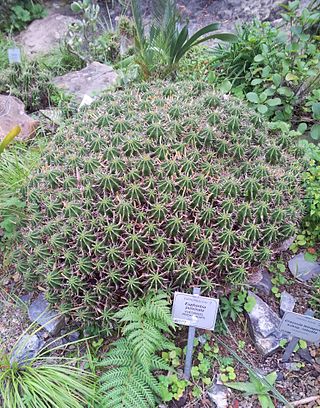
Euphorbia is a very large and diverse genus of flowering plants, commonly called spurge, in the family Euphorbiaceae. "Euphorbia" is sometimes used in ordinary English to collectively refer to all members of Euphorbiaceae, not just to members of the genus.

Joseph Marie Henry Alfred Perrier de la Bâthie was a French botanist who specialized in the plants of Madagascar.
Susan Carter Holmes is a botanist and taxonomist. She discovered and catalogued more than 200 plants of the family Euphorbiaceae. Her plants and articles are published under her maiden-name Susan Carter.

Astrophytum asterias is a species of cactus in the genus Astrophytum, and is native to small parts of Texas in the United States and Mexico. Common names include sand dollar cactus, sea urchin cactus, star cactus and star peyote.

Euphorbia abdelkuri is a species of plant in the family Euphorbiaceae. It is endemic to Abd al Kuri, an island south of Yemen. Its natural habitat is rocky areas. The Latex of the plant is toxic.
Euphorbia analalavensis is a species of plant in the family Euphorbiaceae. It is native to northern and western Madagascar and the Comoro Islands. Its natural habitat is dry deciduous forest and rocky areas between 50 and 400 meters elevation. It is threatened by habitat loss.

Euphorbia arbuscula is a species of plant in the spurge family (Euphorbiaceae). It is endemic to the archipelago of Socotra in Yemen. Its natural habitats are subtropical or tropical dry forests and subtropical or tropical dry shrubland.

Euphorbia misera is a semi-succulent shrub in the genus Euphorbia commonly known as the cliff spurge or coast spurge. A drought-deciduous shrub, it is typically found as a gnarled, straggly plant occupying seashore bluffs, hills and deserts. Like other members of its genus, it has a milky sap, which can be found exuding out of the light gray bark when damaged. The alternately-arranged leaves are round and folded in the middle, with small hairs on them. The "flowers" can be found blooming year-round, and are colored maroon or yellow in the center with 5 white to light-yellow petal-like appendages attached outside. This species is native to the Baja California peninsula and Sonora in Mexico, and the coast of southern California in the United States, where it is a rare species. It is threatened in some localities by the development of its coastal habitat, which tends to be prime locations for high-end residential and commercial developments.

Euphorbiaceae, the spurge family, is a large family of flowering plants. In English, they are also commonly called euphorbias, which is also the name of the type genus of the family. Most spurges, such as Euphorbia paralias, are herbs, but some, especially in the tropics, are shrubs or trees, such as Hevea brasiliensis. Some, such as Euphorbia canariensis, are succulent and resemble cacti because of convergent evolution. This family has a cosmopolitan global distribution. The greatest diversity of species is in the tropics; however, the Euphorbiaceae also have many species in nontropical areas of all continents except Antarctica.

Euphorbia obesa is a subtropical succulent species of flowering plant in the genus Euphorbia. It comes from the south-central Cape Provinces of South Africa. Sometimes referred to as the baseball plant.

Euphorbia balsamifera is a flowering plant in the spurge family Euphorbiaceae. It is distributed in the Canary Islands and the western Sahara. It is the vegetable symbol of the island of Lanzarote. Euphorbia adenensis has been treated as a subspecies of this species.

Euphorbia caput-medusae is a plant of the genus Euphorbia that occurs in and around Cape Town, South Africa.

Boucerosia frerei is a plant in the genus Boucerosia which contains several species many of which are native to the Indian subcontinent and one species, Boucerosia crenulata, native to Myanmar. B. frerei, is a small succulent endemic to the forest area in the Western Ghats and Deccan plateau in Maharashtra state in India. It is also grown as a greenhouse plant by succulent plant enthusiasts. At one time, it was on the IUCN list of twelve most endangered species on earth, but conservation efforts have brought it back from the brink of extinction.

Euphorbia royleana is a species of flowering plant in the family Euphorbiaceae. It is also known as Sullu spurge, and Royle's spurge. It is a succulent and almost cactus like in appearance although unrelated. It grows right across the Himalaya mountains from Pakistan, India, Bhutan, Myanmar, Nepal to western China, It prefers dry and rocky slopes between 1000 and 1500 meters, but has been found up to 2000 meters. Flowering and fruiting is in spring to early summer (March–July) and seeding is in June–October. It is used as a hedging plant in northern India and has medicinal uses.

Euphorbia tuckeyana is a species of flowering plants of the family Euphorbiaceae. The species is endemic to Cape Verde. The species is named after James Hingston Tuckey. Its local name is tortolho. The plants are used for tanning hides. As most other succulent members of the genus Euphorbia, its trade is regulated under Appendix II of CITES.

Euphorbia rhombifolia is a species of flowering plant in the Euphorbiaceae family. It is native to Namibia and South Africa, where it is widespread in clay-rich soils, extending as far east as Kwazulu-Natal.

Euphorbia pulvinata, commonly known as the pincushion euphorbia, is a species of plant in the family Euphorbiaceae native to southern Africa.

Euphorbia meloformis, called the melon spurge, is a species of flowering plant in the genus Euphorbia, native to the Cape Provinces of South Africa. A succulent, it has gained the Royal Horticultural Society's Award of Garden Merit.

Euphorbia nivulia is a subtropical succulent species of flowering plant in the family Euphorbiaceae. It is found in the Indian subcontinent and is commonly known as the leafy milk hedge, holy milk hedge or dog's tongue.
Euphorbia ampliphylla is a succulent rainforest tree of the montane rainforests throughout East Africa and belonging to the Spurge Family (Euphorbiaceae). The branches are each about eight inches in diameter and are succulent and three-winged and pachycaulous. Like most euphorbs, it has milky white sap. The toxicity of many euphorbs is well known, but no specific information is available concerning E. ampliphylla. It is used locally for medical purposes. It is particularly noted for two things: It is the tallest of all known succulent plants, definitely up to 98 feet and indicated on a carefully scaled diagram as reaching 105 feet. It is also the world's only known succulent rainforest tree.

















